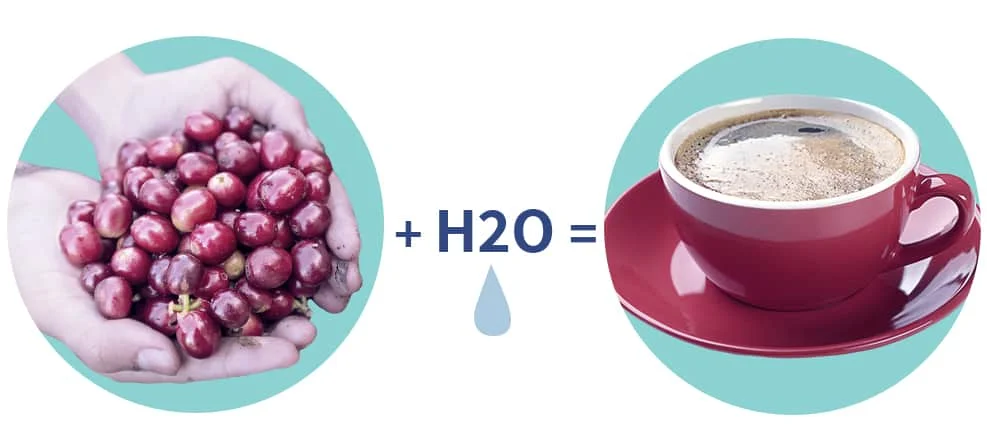Whether you suffer from sleepless nights or simply enjoy an energetic buzz while going over your morning emails, chances are you’re one of the millions of folks who regularly consume caffeine. Present in tea, coffee, chocolate, and energy drinks, this potent little alkaloid is not only a popular stimulant, but also the most widely consumed psychoactive drug in the world.
Curious to know which drinks contain the most caffeine? Check out our infographic below to find out!

Want to share this infographic? Use this link or the embed code below!
Top 45 Beverages Ranked by Caffeine Per Ounce
At 714.3 mg per fluid ounce, DynaPep has the highest caffeine content per ounce of any beverage on the market. Fortunately, it comes in tiny 0.14-ounce portions.
Despite DynaPep’s minuscule size, it packs a powerful punch. The time-released microshot (created by Florida company Intocell) claims to increase focus and boost energy for up to 10 hours. It contains a derivative of methylhexanamine, a stimulant that is believed to actually have a negative effect on mental clarity. Reports of dangerously elevated heart rates are also associated with this drug.
On an ounce-by-ounce basis, coffee overall delivers more caffeine than energy supplements, shots, and drinks. Devil Mountain Co. Black Label Brewed Coffee is believed to have the most caffeine per ounce at 129.6 mg.
And when it comes to brand name caffeine, Coffee Bean & Tea Leaf’s regular coffee packs the most caffeine per ounce at 20.8 mg. That’s more than twice the amount of caffeine offered in McDonald’s coffee (9.1 mg per fluid ounce). Starbucks lands a close second at 20.6 mg per fluid ounce, with Dunkin’ Donuts lagging behind at 15 mg.
Phew, we know! These numbers are intense. While an average fluid ounce of coffee typically features just 12 mg of caffeine, the beverages on this list soar well beyond that. Like us, you’re probably wondering if ingesting that much liquid energy is actually, well, safe. The long and short of it is… maybe.
But before we get into that, let’s take a step back and chat about what caffeine actually is.
How Is Coffee Made?
Caffeine is a bitter, white crystalline purine of the methylxanthine class found in over 60 varietals of plants, seeds, and leaves in Africa, East Asia, and South America. While some anecdotal evidence suggests that caffeinated tea was discovered by Chinese Emperor Shennong in as early as 3000 BCE, it’s generally accepted that the first credible case of coffee consumption came in the 15th century in the Middle East. Over the next 200 years, it would spread throughout the region, into Asia, and then eventually into Europe by the 18th century. (1)
Nowadays, about 90 percent of Americans consume caffeine in some shape or form during the day. (2) This number is consistent with global statistics, with some experts gauging that over 2.25 billion cups of coffee are served daily.
So, how exactly do we get from leaves to one of the world’s most booming industries? Typically, farmers soak the plants in water until the liquid has been infused with the purine’s properties. As deceptively simple as that! For this reason, the strength of any given batch of coffee (or tea, or chocolate) can vary depending on the specific plants used.

Can You Have Too Much Caffeine?
The subject of caffeine consumption has long been a topic of interest for modern researchers and scientists. Does too much cause memory loss? What about hypertension or anxiety? Is there even a thing as too much caffeine? Unlike other substances on the market, caffeine isn’t really regulated at all, so people can truly ingest as much of the stuff as they want. But at what cost?
All in all, regular and even heavy amounts of caffeine use appear to be totally fine for healthy adults. A 2017 analysis of dozens of reports, papers, and experiments on the subject found that adults can safely consume 400 mg/day without suffering from adverse effects on cardiovascular health, calcium balance and bone status, behavior, cancer risk, or fertility. The prescribed number decreases to 100 mg/day for healthy adolescents (12-18 years old) and 2.5 mg/day for children (younger than 12 years old). (3) So while a single Dynapep may indeed be “too much,” most folks can safely intake several cups of coffee before even approaching the danger zone.
However, there are certain populations for whom caffeine consumption becomes a little trickier. According to the above report, groups such as pregnant and lactating women, young children, and people with underlying heart or mental health conditions may need to avoid caffeine altogether.
How Long Does Caffeine Keep You Awake?
While that’s all well and good, we are of course a sleep website, so feel it’s important to chat a bit about the caffeine effect on sleep cycle.
It basically works like this: When the brain is tired, it creates more of a substance called adenosine, which binds to adenosine receptors to slow down nerve cell activity. Caffeine tricks these receptors by essentially pretending to be adenosine, thereby binding to the receptors and blocking the sleep-inducing element. The more caffeine, the more receptors that are blocked.
The result is a nearly instantaneous feeling of wakefulness that can last for up to 3–4 hours. Though it may seem like a pitch perfect solution to drowsiness, the drawbacks are numerous: headaches, eventual grogginess, and increased anxiety, to name just a few. Studies have also shown that increased caffeine consumption during the day can lead to serious sleep problems at night, with one report suggesting that individuals should stop ingesting caffeine 6 hours before bedtime. (4)
The solution? As with any mood-altering substance, it’s moderation. Grab a cup of coffee in the morning, but also remember to establish a consistent bedtime and get yourself the best mattress for your sleep preferences. Snag a soda after work if you’re feeling sluggish, but don’t skimp on the nighttime practices you’ve put in place to catch those sweet, sweet Zzz’s.
Need help falling asleep? Snag one of the best pillows!
Top 5 Drinks With the Most Caffeine Per Ounce
| Rank | Drink and Serving Size in fl oz | Caffeine Per Ounce |
| 1 | DynaPep (.14 fl oz) | 714.3 mg/fl oz |
| 2 | Tube Shot Energy Shot (.3 fl oz) | 666.7 mg/fl oz |
| 3 | NRG MicroShot (.2 fl oz) | 650.0 mg/fl oz |
| 4 | Liquid Caffeine (1 fl oz) | 500.0 mg/fl oz |
| 5 | Energy Catalyst (.23 fl oz) | 434.8 mg/fl oz |
Top 5 Most Caffeinated Regular Coffees From Chain and Drive-Thru Restaurants
| Rank | Coffee Chain | Caffeine per Ounce in Their Regular Coffee |
| 1 | Coffee Bean & Tea Coffee | 20.8 mg/fl oz |
| 2 | Starbucks Coffee | 20.6 mg/fl oz |
| 3 | Caribou Coffee | 19.1 mg/fl oz |
| 4 | 7 Eleven Coffee | 17.5 mg/fl oz |
| 5 | Peet’s Coffee | 16.7 mg/fl oz |
References
- Fredholm, BB. “Notes on the History of Caffeine Use.” Handbook of Experimental Pharmacology , 2011, pp. 1–9., doi:10.1007/978-3-642-13443-2_1. PubMed.
- “About Caffeine.” About Caffeine | Villanova University.
- Temple, Jennifer L., et al. “The Safety of Ingested Caffeine: A Comprehensive Review.” Front Psychiatry, 26 May 2017, doi:10.3389/fpsyt.2017.00080. PubMed.
- Drake, Christopher, et al. “Caffeine Effects on Sleep Taken 0, 3, or 6 Hours before Going to Bed.” Journal of Clinical Sleep Medicine, American Academy of Sleep Medicine, 15 Nov. 2013.



























